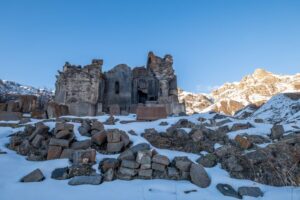Nestled amidst the towering cliffs of the Azat Valley in Armenia, lies a sanctuary of profound spiritual significance and architectural brilliance: Geghard Monastery Armenia. More than just a collection of ancient stones, Geghard is a testament to Armenian faith, artistry, and its enduring connection to the natural world. This UNESCO World Heritage site beckons travelers with its enigmatic charm, inviting exploration into a world where sacred spaces are carved directly into the living rock. Prepare to be captivated by the intricate carvings, the echoing chambers, and the sheer audacity of human ingenuity that defines this remarkable monument.
A History Etched in Stone: The Origins of Geghard
The story of Geghard Monastery Armenia begins long before its present-day form. Legend traces its origins back to the 4th century, when St. Gregory the Illuminator, the patron saint of Armenia, is said to have established a hermitage here. The site’s early name, Ayrivank, meaning “Monastery of the Cave,” reflects its initial construction within natural caves. However, the most significant period of development occurred in the 13th century, under the patronage of the Proshian princely family.
It was during this era that the majority of the rock-cut churches and tombs were carved, transforming the site into the architectural marvel we see today. The monastery gained further prominence due to its association with the Holy Lance, the spear believed to have pierced the side of Christ. This relic, brought to Armenia according to tradition, attracted pilgrims and solidified Geghard’s status as a major religious center. While the Holy Lance is now housed in the Echmiadzin Cathedral treasury, its presence at Geghard for centuries contributed significantly to the monastery’s historical importance and spiritual aura.
The Proshian Dynasty: Architects of Faith

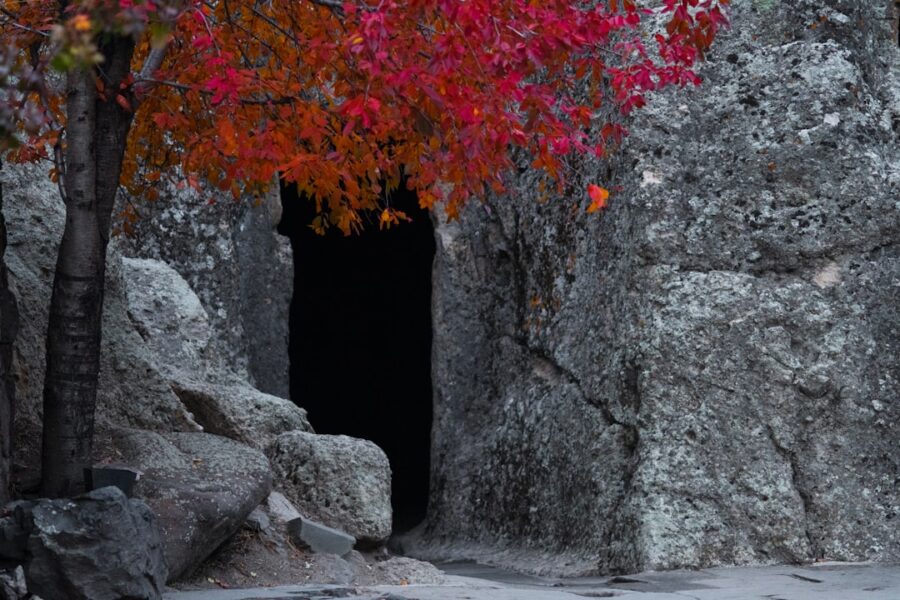
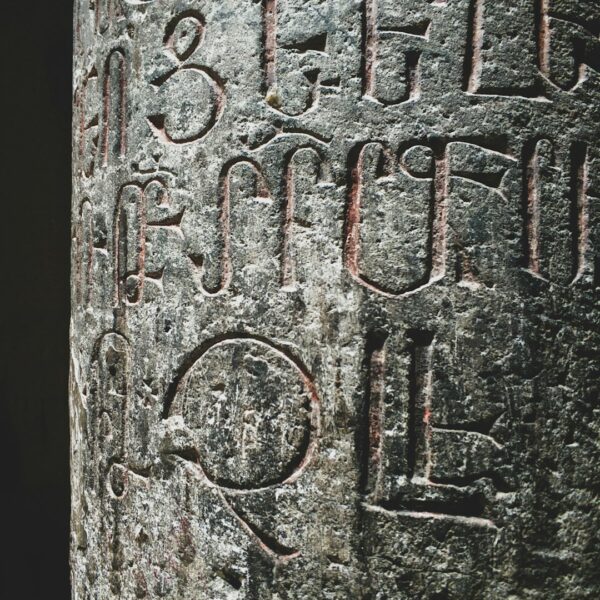
The Proshian family’s influence on Geghard Monastery Armenia cannot be overstated. They commissioned the construction of the most elaborate cave churches, including the Astvatsatsin (Holy Mother of God) chapel, the Avan (Vestry), and the family tomb. Their patronage transformed a relatively simple cave monastery into a complex of interconnected chambers, adorned with intricate carvings that reflect both religious themes and the Proshian family’s heraldic symbols. The Proshians were not merely patrons; they were active participants in shaping the monastery’s artistic and architectural identity, leaving an indelible mark on its character.
Architectural Marvel: A Symphony of Stone and Light
The architectural genius of Geghard Monastery Armenia lies in its seamless integration with the surrounding landscape. The monastery is not simply built near the cliffs; it is carved directly into them, blurring the lines between the natural and the man-made. This unique approach creates a sense of awe and wonder, as visitors navigate through chambers that seem to emerge organically from the rock. The play of light and shadow within these spaces further enhances the mystical atmosphere, creating a truly unforgettable experience.
Key Architectural Features:
- The Katoghike Church (Principal Church): Built in 1215, this is the only structure at Geghard that is not entirely rock-cut. Its cruciform plan, central dome, and elaborate portal carvings showcase the classic features of Armenian church architecture.
- The Astvatsatsin Chapel: Carved into the rock face, this chapel is a masterpiece of Armenian artistry. Its intricate carvings depict religious scenes and the Proshian family’s coat of arms, demonstrating the close relationship between faith and patronage.
- The Avan (Vestry): Located adjacent to the Katoghike Church, the Avan serves as a connecting space and features a unique rock-cut staircase leading to upper chambers.
- The Gavit (Narthex): This large, square chamber serves as the entrance to the cave churches. Its massive scale and intricate carvings create a powerful impression, preparing visitors for the sacred spaces beyond.
- The Family Tomb: Carved deep into the rock, the Proshian family tomb is a testament to their power and influence. The carvings within the tomb are particularly elaborate, reflecting the family’s status and devotion.
- The Upper Jhamatun: Accessed via a narrow passage, this chamber features a unique acoustic quality, making it ideal for chanting and meditation.
- The Spring: A natural spring flows through the monastery complex, providing a source of fresh water and adding to the site’s spiritual significance. Legend holds that the water possesses healing properties.
The carvings at Geghard Monastery Armenia are a particularly noteworthy aspect of its architecture. These intricate reliefs depict a variety of subjects, including crosses, floral motifs, geometric patterns, and scenes from the Bible. The level of detail and artistry is truly remarkable, showcasing the skill and dedication of the Armenian craftsmen who created them. Look closely and you’ll find hidden symbols and subtle nuances that add to the monastery’s enigmatic charm.
Spiritual Significance: A Place of Pilgrimage and Prayer
For centuries, Geghard Monastery Armenia has been a place of pilgrimage and prayer. Its remote location, its association with the Holy Lance, and its unique architectural features have all contributed to its spiritual significance. Even today, visitors from around the world come to Geghard to experience its sacred atmosphere and to connect with the deep history of Armenian Christianity.
Rituals and Traditions:
- Lighting Candles: A common practice at Geghard is to light candles in the various chapels and chambers. This act symbolizes prayer, devotion, and the desire for spiritual illumination.
- Making a Wish: Many visitors believe that making a wish while touching the walls of the cave churches will bring good fortune.
- Tying Ribbons: It is customary to tie ribbons to the trees and bushes surrounding the monastery as a symbol of hope and remembrance.
- Drinking from the Spring: The water from the natural spring is believed to have healing properties, and many visitors drink from it or collect it to take with them.
- Attending a Service: If you have the opportunity, attending a service at Geghard can be a deeply moving experience. The chanting and prayers resonate within the rock-cut chambers, creating a powerful and unforgettable atmosphere.
The atmosphere at Geghard Monastery Armenia is one of profound peace and tranquility. The echoing chambers, the flickering candlelight, and the constant murmur of prayers create a sense of otherworldliness. Whether you are a religious pilgrim or simply a curious traveler, a visit to Geghard is sure to leave a lasting impression.
Planning Your Visit: Practical Tips and Actionable Advice

Visiting Geghard Monastery Armenia is a relatively straightforward process, but a little planning can help you make the most of your experience. Here are some practical tips and actionable advice to consider:
Getting There:
- By Car: The most convenient way to reach Geghard is by car. The monastery is located approximately 40 kilometers southeast of Yerevan, the capital of Armenia. The drive takes about an hour on well-maintained roads.
- By Taxi: Taxis are readily available in Yerevan and can be hired for a day trip to Geghard. Be sure to negotiate the price beforehand.
- By Tour: Numerous tour operators offer guided tours to Geghard, often combined with a visit to the nearby Temple of Garni. This is a convenient option if you prefer not to drive or arrange transportation yourself.
- By Public Transport: While possible, reaching Geghard by public transport is less convenient. You can take a marshrutka (minibus) from Yerevan to Garni and then hire a taxi for the remaining distance to Geghard.
What to Expect:
- Dress Code: As a religious site, Geghard has a modest dress code. Women should cover their heads and shoulders, and both men and women should avoid wearing shorts or revealing clothing. Scarves are often available for free at the entrance.
- Entrance Fee: There is a small entrance fee to visit Geghard Monastery.
- Photography: Photography is allowed inside the monastery, but flash photography is generally discouraged.
- Crowds: Geghard can be quite crowded, especially during peak season (summer months). To avoid the crowds, consider visiting early in the morning or later in the afternoon.
- Accessibility: The monastery complex involves a fair amount of walking and climbing stairs, which may be challenging for visitors with mobility issues.
- Food and Drink: There are a few small shops and vendors near the monastery selling souvenirs, snacks, and drinks. However, it’s a good idea to bring your own water and snacks, especially if you plan to spend several hours exploring the site.
- Restrooms: Restrooms are available near the entrance to the monastery.
Enhance Your Experience:
- Hire a Guide: A local guide can provide valuable insights into the history, architecture, and spiritual significance of Geghard. Consider hiring a guide at the entrance or booking a guided tour in advance.
- Read Up: Before your visit, take some time to read about the history and architecture of Geghard. This will help you appreciate the site more fully.
- Take Your Time: Allow yourself plenty of time to explore the monastery complex. Don’t rush through the chambers; take the time to soak in the atmosphere and admire the intricate carvings.
- Combine with Garni: A visit to Geghard is often combined with a trip to the nearby Temple of Garni, a Hellenistic temple dating back to the 1st century AD. This makes for a full and rewarding day trip.
- Learn a Few Armenian Phrases: Learning a few basic Armenian phrases, such as “Barev dzez” (Hello) and “Shnorhakalutyun” (Thank you), will be appreciated by the locals.
Beyond the Walls: Exploring the Azat Valley
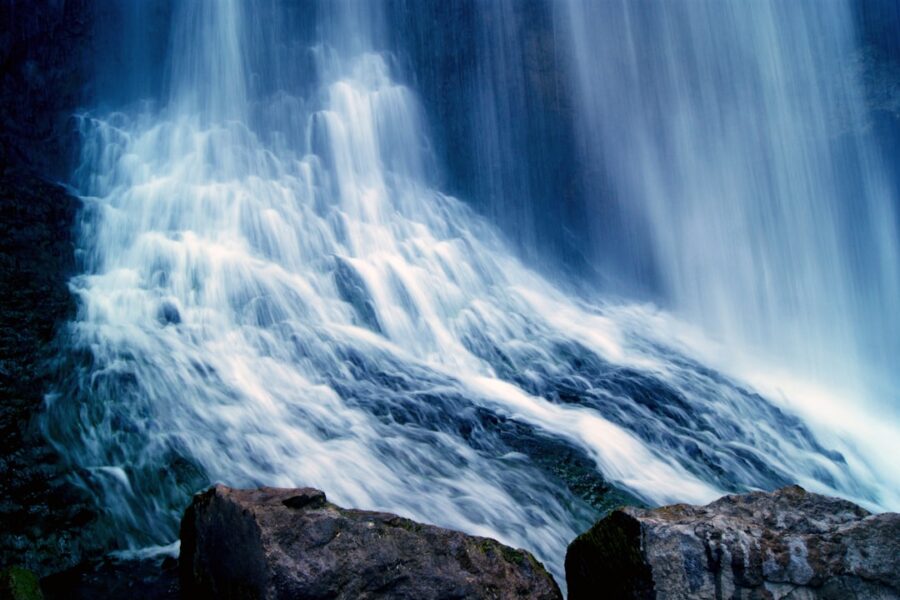
While Geghard Monastery Armenia is undoubtedly the main attraction, the surrounding Azat Valley is also worth exploring. The valley is known for its stunning natural beauty, with towering cliffs, lush vegetation, and the Azat River flowing through its heart. Consider taking a hike in the valley to fully appreciate the landscape that surrounds and complements the monastery.
Points of Interest:
- Symphony of Stones: Located near Garni, this natural rock formation resembles a giant pipe organ, creating a surreal and otherworldly landscape.
- Havuts Tar Monastery: A ruined monastery located high in the mountains above Garni, offering stunning views of the surrounding area.
- Local Villages: Explore the nearby villages to experience the authentic Armenian way of life. You can sample local cuisine, interact with the friendly locals, and learn about their traditions.
Preserving the Legacy: Conservation Efforts
As a UNESCO World Heritage site, Geghard Monastery Armenia is subject to ongoing conservation efforts. These efforts are aimed at preserving the monastery’s architectural integrity, protecting its cultural heritage, and ensuring its long-term sustainability. The Armenian government, along with international organizations, is working to address issues such as erosion, structural damage, and the impact of tourism. By visiting Geghard responsibly and respecting its sacred environment, you can contribute to its preservation for future generations.
A Timeless Treasure: Why Geghard Monastery Endures
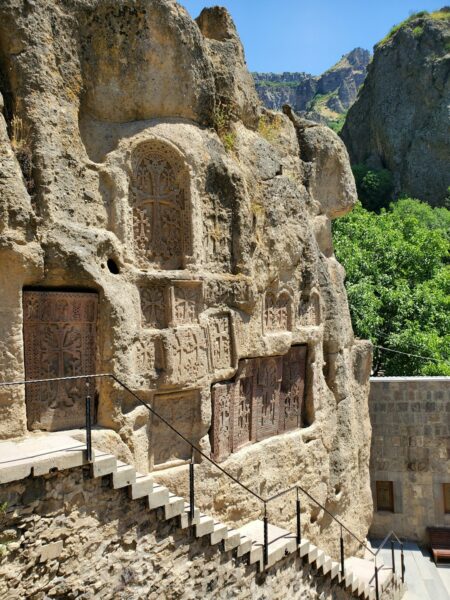
Geghard Monastery Armenia is more than just a historical monument; it is a living testament to the enduring power of faith, artistry, and human ingenuity. Its unique architecture, its spiritual significance, and its stunning natural setting combine to create an experience that is both profound and unforgettable. As you explore its echoing chambers, admire its intricate carvings, and soak in its sacred atmosphere, you will understand why Geghard Monastery continues to captivate and inspire visitors from around the world. It is a place where history comes alive, where faith finds expression in stone, and where the beauty of nature and the brilliance of human creativity converge.
So, plan your trip, immerse yourself in the history, and discover the magic of Geghard Monastery Armenia. You won’t be disappointed.



